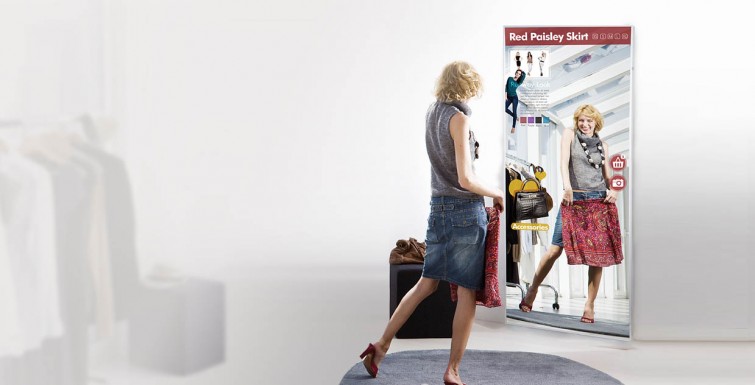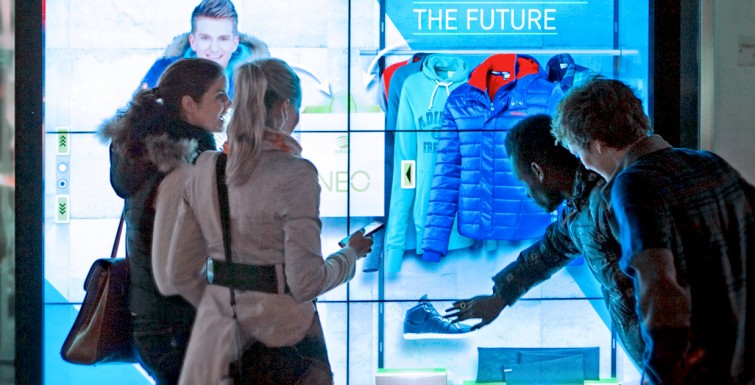Elevate your traditional mirror into a futuristic, appealing display that brings a ‘wow’ factor to any customer-facing environment. Samsung’s MLE Series display is a multi-functional hybrid display that adds unparalleled clarity and readily-available information to any mirror setting. The polarized film overlay within MLE displays ensures higher transmittance and reflectance in order to attain a more realistic product view. The MLE Series displays add ambience to any retail setting through a sleek, pristine design. With an embedded proximity sensor, built-in WiFi and integrated Samsung MagicInfo software, MLE displays can be leveraged as an all-in-one retail solution, allowing for the displays to become a valuable tool for driving and managing retail sales.
A Captivating Mirror/Signage Hybrid Display
Samsung’s MLE mirror displays create a more engaging and informative customer experience by combining the power and reach of digital signage with the visual clarity of a standard mirror. Featuring high (55 percent) reflectance, the MLE displays clearly portray both real-time mirror imagery and complementary content with minimal visual impairment. Through improved visual accuracy, the MLE display can serve as a valuable sales tool that persuades and informs customers.

Clearer, More Visible Presentation
The unique composition of Samsung’s MLE mirror displays offers consumers a more realistic and complete product view. Featuring a polarized film overlay, the MLE mirror displays deliver superb transmittance (90 percent) and advanced reflectance (55 percent) that reduce visual distraction. As a result, customers can enjoy clearer and more vivid content than standard half-mirror format alternatives offer while simultaneously receiving higher-performing mirror visibility.

Distraction-Free Design
Samsung’s MLE displays elevate the traditional mirror through a bezel-free design that further keeps viewers focused on reflected and shared content rather than on the signage itself. Additionally, this bezel-free composition grants retail owners added flexibility to take their mirror display arrangements even further. Several MLE displays can be combined into unique, video-wall style arrangements without gaps or inconsistencies between screens, generating endless visual possibilities.

Seamless Mirror and Content Transition
As shoppers approach and depart, the MLE displays’ embedded proximity sensor instinctively transitions between traditional promotional signage and a clear mirror. Retailers can set the sensors to activate once motion is detected at one of three distances (0.7m, 1.0m and 1.5m), while also pre-setting the display to shrink (small-image mode) or expand (full-image mode) featured imagery. Users also have the flexibility to set the shape and position of the expanded or contracted content to match specific motions.

Easy Content Control
Enjoy the versatility of expanded connectivity to mobile devices, from easy media sharing and screen control to simple content mirroring from a tablet or mobile phone to your display. With Samsung MagicInfo content management software, selecting and scheduling software is simple to control with either an RS232 or LAN/WiFi connection.

Powerful System-on-Chip Performance With a Quad Core CPU
Powered by a System-on-Chip (SoC) semiconductor and quad core CPU with 8GB of storage, Samsung’s SMART Signage Platform is an open and integrated player side media platform that provides a powerful, streamlined solution to reduce TCO for digital signage deployments, through savings in hardware, installation and operating costs

Enhanced Connectivity Options
2 USB, DVI, DP, HDMI, Component and Composite inputs provide enhanced connectivity to meet your business’ digital signage needs.




